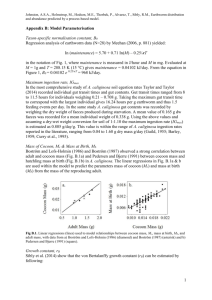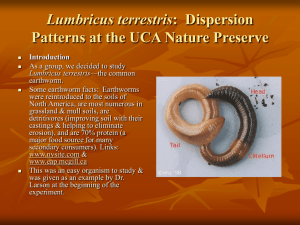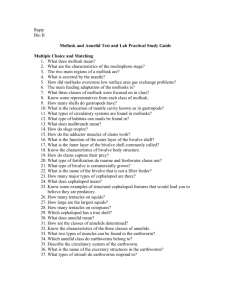Cosmopolitan Earthworms - Annelid Resources at annelida.net
advertisement
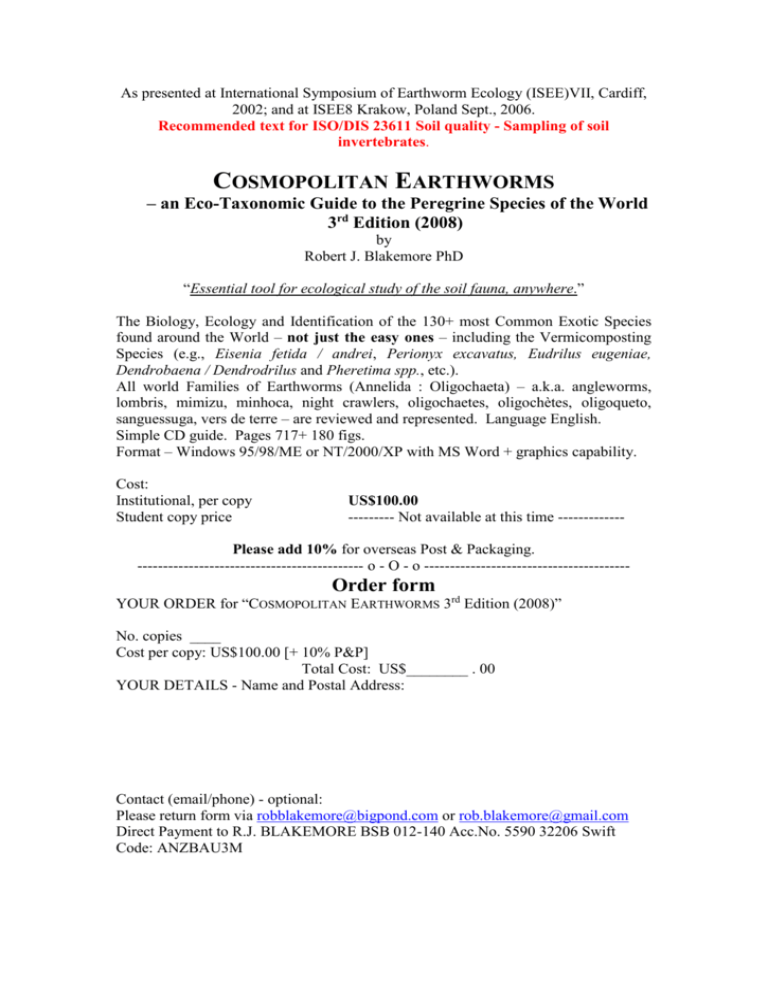
As presented at International Symposium of Earthworm Ecology (ISEE)VII, Cardiff, 2002; and at ISEE8 Krakow, Poland Sept., 2006. Recommended text for ISO/DIS 23611 Soil quality - Sampling of soil invertebrates. COSMOPOLITAN EARTHWORMS – an Eco-Taxonomic Guide to the Peregrine Species of the World 3rd Edition (2008) by Robert J. Blakemore PhD “Essential tool for ecological study of the soil fauna, anywhere.” The Biology, Ecology and Identification of the 130+ most Common Exotic Species found around the World – not just the easy ones – including the Vermicomposting Species (e.g., Eisenia fetida / andrei, Perionyx excavatus, Eudrilus eugeniae, Dendrobaena / Dendrodrilus and Pheretima spp., etc.). All world Families of Earthworms (Annelida : Oligochaeta) – a.k.a. angleworms, lombris, mimizu, minhoca, night crawlers, oligochaetes, oligochètes, oligoqueto, sanguessuga, vers de terre – are reviewed and represented. Language English. Simple CD guide. Pages 717+ 180 figs. Format – Windows 95/98/ME or NT/2000/XP with MS Word + graphics capability. Cost: Institutional, per copy Student copy price US$100.00 --------- Not available at this time ------------- Please add 10% for overseas Post & Packaging. -------------------------------------------- o - O - o ---------------------------------------- Order form YOUR ORDER for “COSMOPOLITAN EARTHWORMS 3rd Edition (2008)” No. copies ____ Cost per copy: US$100.00 [+ 10% P&P] Total Cost: US$________ . 00 YOUR DETAILS - Name and Postal Address: Contact (email/phone) - optional: Please return form via robblakemore@bigpond.com or rob.blakemore@gmail.com Direct Payment to R.J. BLAKEMORE BSB 012-140 Acc.No. 5590 32206 Swift Code: ANZBAU3M COSMOPOLITAN EARTHWORMS CD TABLE OF CONTENTS PAGES Dedications & Acknowledgements ….………….…..………………………..……. i Preface to Editions .......................................................................................……..... iii 1. GENERAL INTRODUCTION Background ................................................................................…....................…. 3 Characters and origins of peregrine species ….....................…........................... 7 Translocation and export of Australian native species ……..……………......... 8 2. BIOLOGY AND ECOLOGY Origins …………………………………………..……........................................... 11 Earthworm biology, morphology and reproduction ………............................... 14 Hybridization …......................………………………............................................ 15 Biometry, Size range ………………………..……................................................ 16 Longevity …......................…………………..……................................................. 19 Regeneration ....................…………………..……................................................. 20 Predators, parasites, pathogens & symbionts ..................................................... 21 Population abundance & diversity ……………................................................... 24 Table 1. Reports of diversity & abundance in various habitats of Australia. Biodiversity resources and regional distributions …............……...................... 27 Rates of spread of introduced earthworms ……..……....................................... 35 Ecological strategies …......................……..…...................................................... 37 Behavioural trials ………..……............................................................................ 41 Temperature and moisture tolerances …............................................................. 42 Effects on soil processes ….....................…………............................................... 43 Introduction Nutrient cycling Water relationships Soil structure Worm casts Burrows & roots Root mats and organic matter Mesofauna & Microorganisms Plant growth factors 4. AGRONOMIC POTENTIAL OF EARTHWORMS ……………..................... 52 Effects on plant production Table 2. Summary of pot experiments of earthworm effects on plant yields. Table 3. Summary of field experiments of earthworm effects on plant yields. Programs to introduce earthworms Conclusions on building healthy soils 4. NUTRITIONAL AND MEDICINAL USES .................................................... 65 5. ECO-TAXONOMY………................................................................................ 66 Introduction Collection Inspection Anatomical characters used in taxonomy Identification Problem of parthenogenetic polymorphism Systematics (Linnaean / Binomial taxonomy vs. Cladistics) Summaries of Family Classification/Distributions/Taxonomists …… 92 6. GUIDE TO THE SPECIES ………..…….....…...........................................…. 103 Introductory Keys to the Revised Families of Earthworms ......................…. 104 Approximate Totals for Species of Families ….………..…………………..… 109 Family Enchytraeidae .....................................…...........................................… 110 Family Moniligastridae (e.g Drawida barwelli)….........................................… 111 Family Ocnerodrilidae. (e.g. Ocnerodrilus occidentalis)...............................… 127 Family Acanthodrilidae (e.g Microscolex phosphoreus)................................… 146 Family Octochaetidae (e.g. Dichogaster bolaui)………...............................…. 169 Family Megascolecidae (e.g. Perionyx excavatus)……..................................… 203 Table 4. Key characters to Pheretima-group genera. Keys to common peregrine pheretimoids …………..……….……..…...…… 235 Comments on misidentification of Pheretima browni Stephenson, 1912 .....… 240 Genus Amynthas ........................................…………………….……..…...…… 241 Possible synonyms of Perichaeta barbadensis Beddard, 1892 .................. 270 Genus Metaphire ........................................…………………….……..…...…… 317 Metaphire hilgendorfi / Amynthas tokioensis spp-complex…………….... 327 Genus Pheretima s. stricto ........................…………………….……..…...……. 361 Genus Polypheretima ……........................…………………….……..…...……. 382 Family Glossoscolecidae (e.g. Pontoscolex corethrurus)..........…..................….. 397 Family Eudrilidae (e.g. Eudrilus eugeniae)…...........................…..................…. 406 Family Almidae ...................................….....................................…...……….…. 412 Family Criodrilidae (e.g. Criodrilus lacuum)..................................….........….… 416 Family Sparganophilidae .......................…......................................…............… 425 Family Lumbricidae (e.g. Lumbricus terrestris).................................….............. 430 Keys to peregrine lumbricid genera/species Table 5. Characters differentiating common lumbricid genera. Tables 6 & 7. Differentiating Aporrectodea caliginosa species-complex s. Blakemore. Genus et species dubiae Lumbricidarum ……………….……………………… 581 7. APPENDICES and REFERENCES ...................................................……........ 582 Glossary Conventions (Taxonomic and Earthworm Identifications) Abbreviations Definitions ………………………………………….…………………... 585 References / BIBLIOGRAPHY ...................……………………......……..... 608-717 Table 8. Non-endemic earthworms from various regions of the world. Dec., 2008


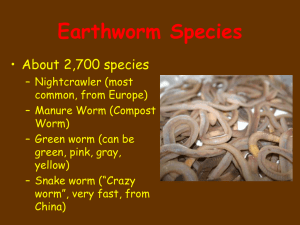
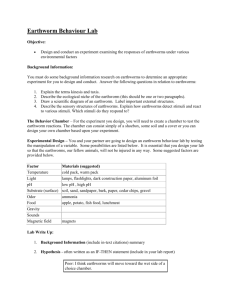

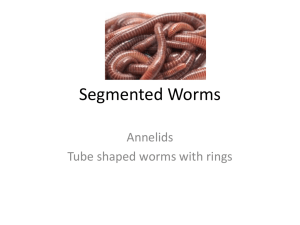
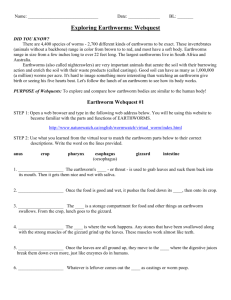
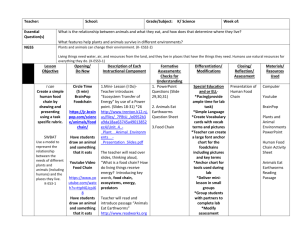
![earthworm [annelid – segmented worm]](http://s3.studylib.net/store/data/008502476_1-3ebb28d32ff3e90b09ed01ec69126429-300x300.png)
